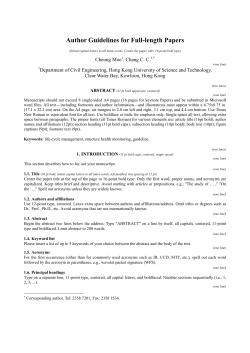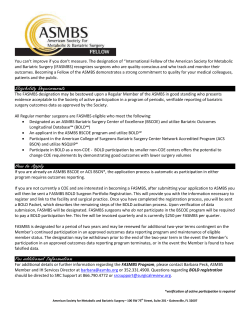
How to Use Cap RED Tools to assist with research data
How to Use REDCap
Tools to assist with research data
capture and storage
Joshua Franklin
joshuadf@uw.edu
ITHS Biomedical Informatics
Bryan Comstock
bac4@uw.edu
ITHS Center for Biomedical Statistics
Objectives
1. Present an overview of REDCap:
– What it does
– Where it is
– How to get started.
2. Set up of a REDCap database
3. Present three example studies where REDCap
is in active use.
Basics of ITHS REDCap
• REDCap (Research Electronic Data Capture) is a
simple, fully web based EDC system
• Originally developed at Vanderbilt University
specifically for clinical research studies
• Easy to get started designing your project(s),
extensive online training resources
• I support the ITHS REDCap install used by about
50 projects and 300 users
Change
Settings
Your
Forms
Enter
Data
Basic project tasks: choose a patient record
(above) and (below) for each form/event
according to protocol
More REDCap basics
Step 1: Create a project
Step 2: Develop your study protocol in REDCap
(data entry forms and visits/events)
Step 3: Go into “production” mode and enter
your study data
Step 4: Export data, publish, and archive/delete
project
Note: REDCap has a variety of project types, but
for simplicity I am primarily covering Data
Entry forms with multiple timepoints
What about compliance?
• Shared responsibility of HIPAA compliant
ITHS does REDCap system; you do your study
• Prefer studies with minimal collection of
Protected Health Information (PHI);
– PHI data fields are flagged and can be removed or in
some cases de-identified on export (hash study ID,
shift dates, etc);
– data exports and API can be restricted to key staff
such as PI and biostatistician
• REDCap has a full audit log, who/what/when
How to Get Started
Three Example Studies Using REDCap
1. SHORE Cohort Study:
Shoulder Outcomes Research
2. BOLD Registry:
Back pain Outcomes using Longitudinal Data
3. LESS RCT:
Lumbar Epidural steroid injections for Spinal
Stenosis
Project 1: SHORE Cohort Study
Project Overview – Prospective cohort
• Setting: Scheduled to receive shoulder replacement
surgery
– Single site and one research coordinator
• Sample: 194 of 525 person target enrollment
Data Capture:
• Pre-op, 3, 6, 12, and 24-mo outcomes
• Phone, mail, web survey (Catalyst, REDCap)
• Single REDCap database
Project 2: BOLD Study
Project Overview – Cohort Design using BOLD Registry
• Setting: 3 large HMO recruitment sites (UW DCC)
– Boston, Detroit, San Francisco
– 20+ research coordinators
• Sample: 1,600 of 5,000 person target enrollment
– 65 years and older, first visit for low back pain
– ICD-9 based inclusion and exclusion criteria
Data Capture:
• Baseline, 3, 6, and 12-mo pain/function outcomes
• Phone (CATI), mail
• Two REDCap databases, augmented with web page
Project 3: LESS RCT
Project Overview – Blind (D) Randomized Controlled Trial
• Setting: 6 clinical recruitment sites (UW DCC)
– 12+ research coordinators
• Sample: 75 of 400 person target enrollment
– Age 50+, spinal stenosis, pain > 5 /10, ESI scheduled
– Eligible after *many* screening & imaging criteria
• Intervention: steroid + local anesthetic vs. local
anesthetic
Data Capture:
• Pain, functional outcomes through 12 months
• In-person, phone (CATI), mail
• Four REDCap databases, augmented with web page
Projects 2 and 3 – Augmented REDCap
Crosswalk database
linking patient ID to
study participant ID
Screening / Patient
Identification
Single Log-in BOLD
Project Web Portal
Application Programming Interface (API)
Screening,
Randomization
Automated
Follow-Up Reminders
and Reporting
Study Recruitment Site
Research
study data
Adverse Events
Follow Up and Data Collection
UW DCC
Study Management Using REDCap
Project 1 – SHORE Study
• Direct access / entry to REDCap (https://redcap.iths.org/)
• REDCap scheduling modules enabled
• Monthly recruitment / follow-up reports to PI (via R
script)
Projects 2 and 3 – Augmented REDCap
•
•
•
•
•
•
Access / entry to REDCap through study web portal:
https://backpainproject.org/
Patient screening performed on web page, not REDCap
REDCap scheduling disabled – manage with web page
Data access groups are key for multi-site study
Nightly R reports for recruitment, follow-up, missing data
Miscellaneous: R Code – Read data directly from REDCap
# GET SECRET TOKEN FOR REDCAP PROJECT FROM
JOSHUA
secret_token = 'DC7B3329A7CA1E631D3884xxxxxxxxx'
# Command: READ ALL Study Data into ‘x’:
x = postForm('https://redcap.iths.org/redcap/api/',
token = secret_token,
content='record',
format='csv',
type='flat')
# Now you have a Excel/CSV file to analyze:
write.table(x, file = "delete_file.csv”, sep=“,”)
screeningdb = read.csv("delete_file.csv")
Thanks!
Questions?
© Copyright 2025












